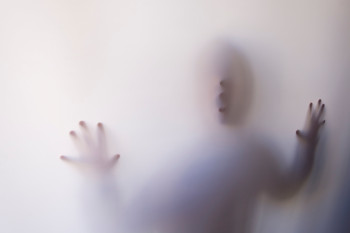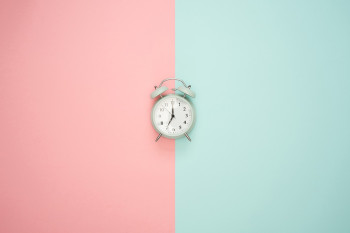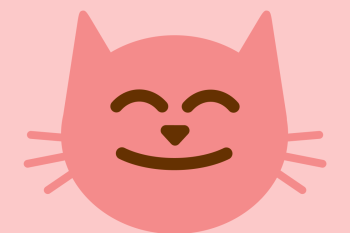© Pint of Science, 2024. All rights reserved.
Substructure was created by Julien Masson after his collaboration with Lucija Strkal, a 1st year PhD student from the University of Nottingham as part of the Creative Reactions Pint of Science #pint21
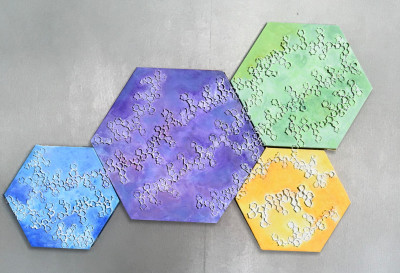
Substructure. Mixed media, mucilage, and pigments by Julien Masson
Julien is a Multimedia Artist and has collaborated in several Art and Science projects in the past and he always found this experience 'challenging but creatively stimulating at the same time'. He was also delighted to be paired with Lucija and having the opportunity to get in touch with her and learn more about her project.
Lucija has a background in nutrition and her thesis was on fiber modification from underutilised sources and application to food, which led her to the decision of combining her knowledge on dietetics with food engineering.
The artwork was based on Lucija’s project which is about the dietary fiber from a plant called Psyllium. She explained that this fiber is unique, both because it expands and creates a strong gel when putting seeds from the pant into water and also because it has a unique molecular structure responsible for strong gelling properties, different form other plants. The gel made by Psyllium fiber is composed of three layers that are not visible by the naked eye and each layer owns a distinct property different from the others! But why should somebody study the fibers? Lucija says:
'Fibre has multiple health benefits, but it is challenging to be incorporated into food products. My goal is to modify its structure, so it still has positive effect on gastrointestinal and cardiovascular health, while enabling its use in different foods, such as gluten-free bread.'
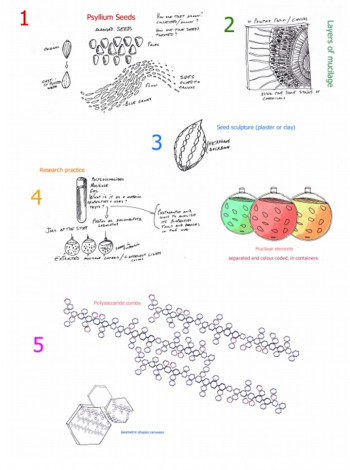
The plan of the artwork by Julien Masson
About the artwork creation, Julien said:
'I first familiarise myself with the subject and brainstorm on a series of concepts. However, time was limited and thus I decided to get a couple of Artworks that weren’t necessary accurate but faithful interpretation of the science whilst keeping an Artistic merit and some originality. The first piece was based on the structure of the Psyllium mucilage and the way Lucija stains it to study its different constituent layers. I echoed this method in my work by working with transparent medium and staining the surface afterwards. The second piece is inspired by the Psyllium polysaccharide comb-like structures. Using extruded PLA I reconstructed the backbones and side chains interlocking into each other on an atomic level.'
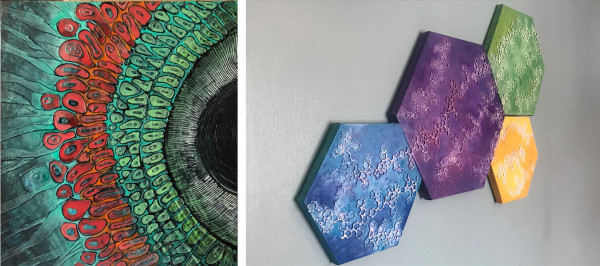
The structure of Psyllium mucilage (left) and The Psyllium polysaccharide comb-like structures (right) by Julien Masson
We asked both to tell us their thoughts on their collaboration.
“I find these collaborative projects invaluable for my practice because they often force me to think outside the box and get out of my comfort zone. I would be very keen to pursue the collaboration and explore opportunities to exhibit the work in different venues. We are even talking about experimenting the mucilage itself mixing with colour pigments for use as a paint medium.” Julien Masson
“For my collaboration with Julien, I prepared a short description of my research and I showed him some photos from previous work on the same subject, and pictures from the fibre in the different stages of the experiments in order to familiarise him with the concept and help him on the illustration. Later, I discussed with Julien any questions he had on the topic”. She was very pleased and surprisingly happy that she managed to collaborate successfully with Julien without knowing each other. Moreover, she liked the interaction with him because she believes that “a scientist is always happy when people ask them about their research.” It is worth to be mentioned that when we asked her about her interest in art before participating in Creative Reactions, she replied that she was not really keen on the crossover between these two fields, art and science and her participation made her realise that art creation can be quite scientific, too. In her words: “We all have common views and that kind of collaborations should be more often”.
Find out more on Julien’s work on Twitter.
If you have any questions on Lucijia’s project, she is happy to be contacted on LinkedIn.
Julien invites you to create your own version of the Psyllium mucilage structure. Download the jpg image file here or get the svg file. Share your coloured-in images with us by tagging @creativerxns and #pint21.
About this post
This blog post is a part of the Creative Reactions Pint of Science 2021 online exhibition. Throughout May and June, we will open the gallery for different examples of collaborations between art and science at creativereactions.com. Find more Creative Reactions blog posts.
Ask questions to Creative Reactions artist in our virtual Q&A form.

